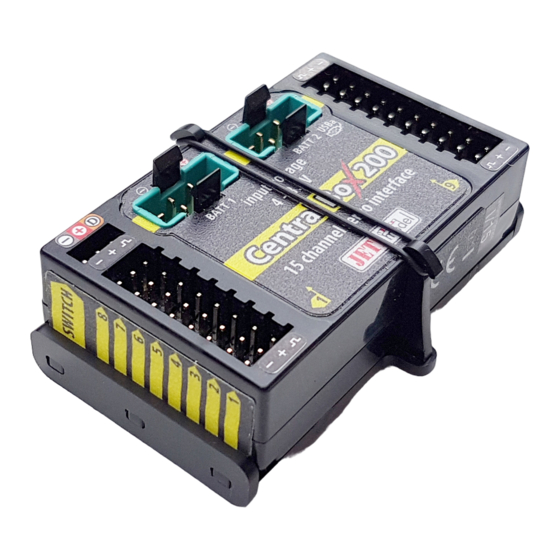Werbung
Verfügbare Sprachen
Verfügbare Sprachen
Quicklinks
Central Box 200 Release Notes
EN – DE - CZ
English
Version 1.20 (May 2014)
The 1.20 firmware version for the Central Box 200 adds a digital interface function to the existing settings
for the output pins. Individual Central Box 200 outputs can now be configured as one of the three modes;
classical servo output, digital output or digital input.
In the digital output mode, only the logical level 1 or 0 is generated on the port configured this way. The
value of this output is reflecting the assigned output channel and its level. If the servo position of the
specified receiver channel is lower than 0%, i.e. 1.5ms (the decision limit point can be set by the user
using the „Trigger" parameter), the output is set to permanent log. 0 (i.e. 0V). If the servo position is
higher than 0%, log. 1 (i.e. 3.3V) will be generated on the pin. In the digital output mode, no control
servo pulses are generated for that particular pin. With logical outputs, the Central Box is even able to
control devices that do not use servo impulse as their input, e.g. lights, sound generators, etc.
Using pins (ports) as inputs is useful for simple feedback without the use of telemetry sensors. For
example: if you attach limit switches to retractable gear, you can have feedback about its condition
during the flight. The condition of the digital inputs is sent via EX telemetry and the user can assign
sounds or alarms to the events.
The Central Box with the new firmware can also function as an EX Bus Expander. This function can be
activated on the Ext1, Ext2 and Ext3 outputs and this will function even if the Central Box is controlled
by the PPM signal (Rx1 and Rx2 input). The Central Box transforms the servo positions from the PPM
signal to the EX Bus.
The Central Box can detect any sensor that can communicate in EX Bus mode and starts the
communication with the sensor automatically using EX Bus protocol.
Setting the Central Box can be done using the JETI DC/DS transmitter via the, „Device Explorer" menu.
To display all adjustable options it is necessary to upload the new Central Box configuration to the
transmitter SD card (in the Devices directory). Configuration files are included in the transmitter update,
version 3.00 and later.
Clarification of certain terms from the setup menu of the Central Box:
Fail-Safe – The behavior of the servo output in the case of signal loss from the transmitter. The setup of
the Fail-Safe positions is possible both in the receiver and the Central Box. If the receiver output is set as
EX Bus or PPM direct, the Fail-Safe position is not generated on these outputs in case of signal loss. Thus
it is advisable to set the Fail-Safe position only on the Central Box outputs.
Fail-Safe - Enabled
- In case the signal is lost on both Rx1 and Rx2 inputs, the Central Box generates the last known
servo positions for a specified period of „SignalFaultDelay". Then, the servo output switches to a mode
dictated by the "SignalFault" setting for the specific output. "Hold", "Out off" and "Fail-Safe" are the
possible modes.
In "Fail-Safe" mode it is possible to select the desired servo position (FS position) and the speed of
transition into this position (FS Speed) after the signal loss is detected.
"Out off" – does not generate any servo signal. This mode is appropriate if the Fail-Safe is generated
directly by the servo.
"Hold" – repetition of the last known servo position on the output.
-1-
Werbung

Inhaltszusammenfassung für JETI model Central Box 200
- Seite 1 The 1.20 firmware version for the Central Box 200 adds a digital interface function to the existing settings for the output pins. Individual Central Box 200 outputs can now be configured as one of the three modes; classical servo output, digital output or digital input.
- Seite 2 Central Box 200 Release Notes EN – DE - CZ Fail-Safe - Disabled - In case of signal loss event on both Rx1 and Rx2 inputs, the Central Box stops generating impulses to servos. Output Period - Determines how often the control pulses for servos are generated on the Central Box outputs.
- Seite 3 Deutsch Version 1.20 (Mai 2014) Die Firmware-Version 1.20 für die Central Box 200 verfügt über eine neue digitale Schnittstellenfunktion zusätzlich zu den bestehenden Einstellungen für die Servosteckplätze. Mit dieser FW können Sie zwischen dem klassischen Servoausgang, Digitalausgang oder Digitaleingang auswählen.
- Seite 4 Central Box 200 Release Notes EN – DE - CZ Impulsgeschwindigkeit - Einstellung bestimmt die Häufigkeit der erzeugten Servoimpulse für die Servos - zwischen 5-30ms Impulsgeschwindigkeit und “Auto” kann gewählt werden - werden digitale Servos verwendet, empfehlen wir die Option “Auto”...
- Seite 5 Central Box 200 s novým firmwarem dále nabízí funkci Expanderu EX Bus, kterou lze aktivovat na výstupech Ext1, Ext2 a Ext3. Tuto funkci lze provozovat i v případě, že je Central Box 200 ovládán PPM signálem (vstup Rx1 a Rx2). Central Box převádí výchylky z PPM signálu na EX Bus.
- Seite 6 Central Box 200 Release Notes EN – DE - CZ Vystupni perioda - Určuje, jak často budou na výstupy Central Boxu 200 odesílány řídicí impulsy pro serva. - Lze nastavit fixní výstupní periodu 5-30ms, popř. periodu Auto. - Při použití digitálních serv je doporučeno použít volbu Auto; pokud jsou použita analogová serva, pak je vhodné...




